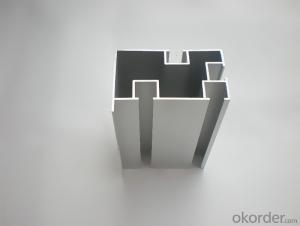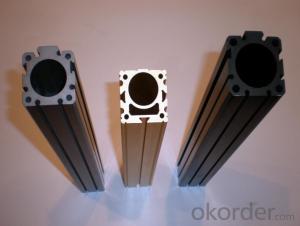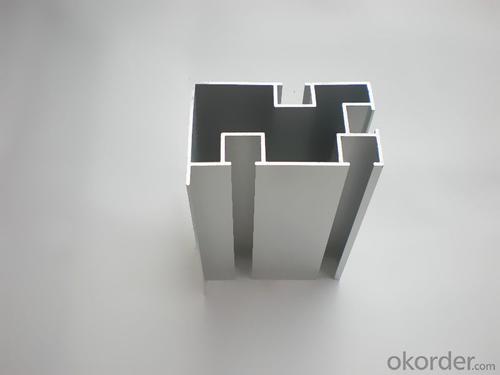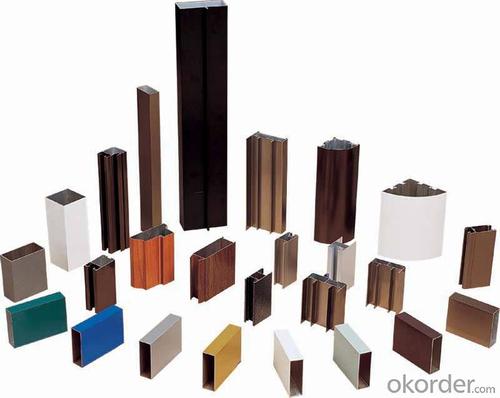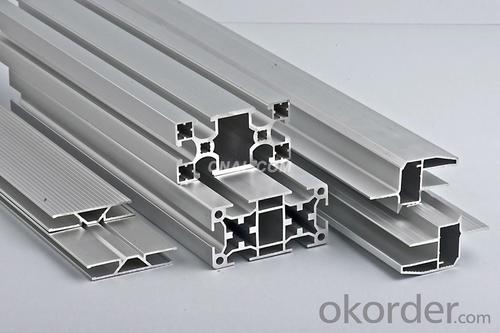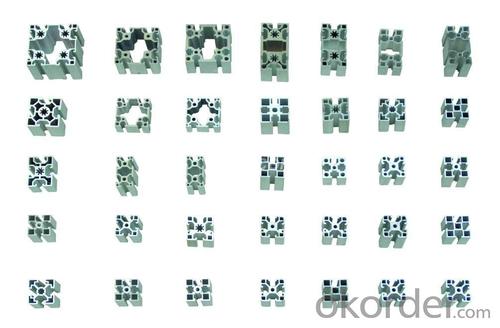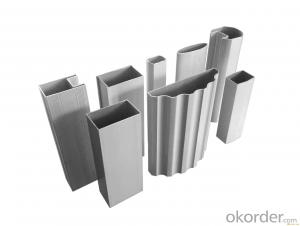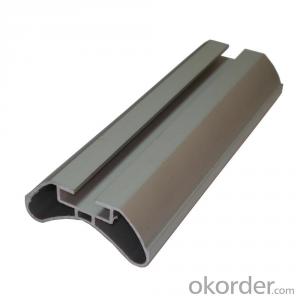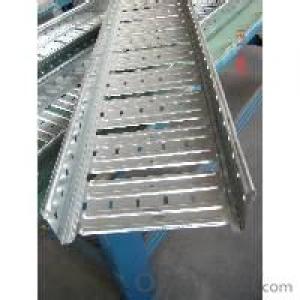Industrial Aluminum Extrusion Profiles T-Slot
- Loading Port:
- China Main Port
- Payment Terms:
- TT OR LC
- Min Order Qty:
- -
- Supply Capability:
- -
OKorder Service Pledge
OKorder Financial Service
You Might Also Like
Aluminium is a relatively soft,durable, lightweight, ductile and malleablemetal with appearance ranging from silvery to dull gray,depending on the surface roughness. It is nonmagnetic and does not easilyignite. A fresh film of aluminium serves as a good reflector (approximately92%) of visible light and an excellent reflector (as much as98%) of medium and far infrared radiation. The yield strength of pure aluminium is 7–11 MPa,while aluminium alloys have yield strengths ranging from200 MPa to 600 MPa. Aluminium has about one-third the density and stiffnessof steel. It iseasily machined,cast, drawn and extruded.
Aluminum Profile
Material | Alloy 6063,6061,6005or according to customer’s choice |
Temper | T3, T4, T5, T6 |
Surface | Anodize, electrophoresis, powder coating, PVDF coating, wood grain painting, matted, etc. |
Length | Coating 6.5 meters, Anodizing 6.5 meters, Mill finish 5 meters |
Application | Industrial, electrical equipment(TV set, air conditioner, refrigerator, computer), decoration,construction, transportation |
Custom Made | We can package following with customer's request. |
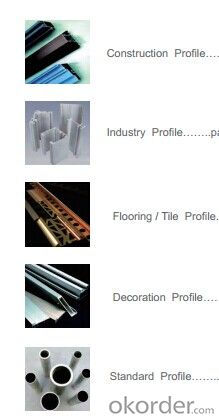
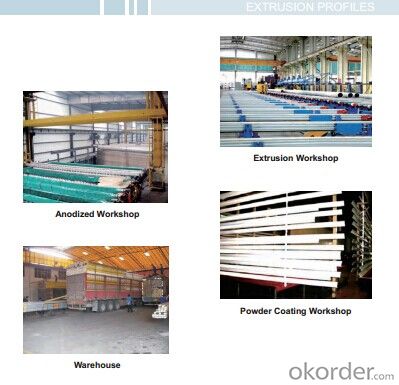
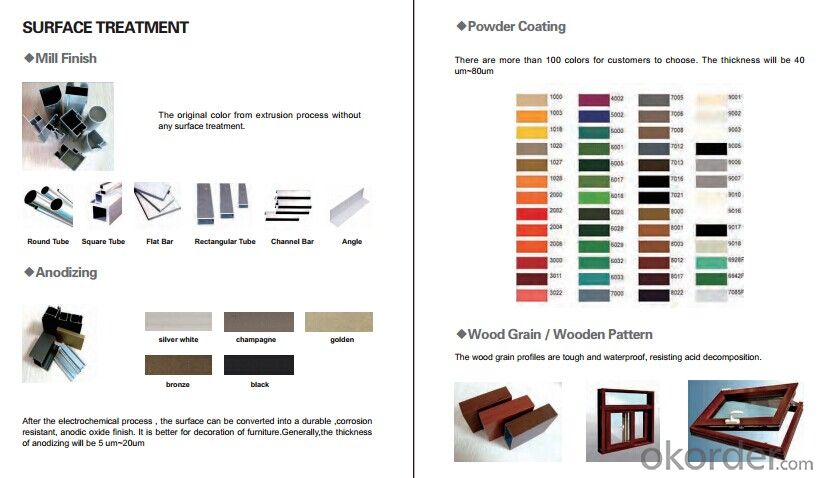
- Q: The user is asking for methods to prevent aluminum profiles from warping or twisting while being installed.
- <p>To avoid warping or twisting of aluminum profiles during installation, ensure proper handling and support. Use sturdy brackets and supports to maintain alignment and prevent bending. Keep the profiles clean and free of debris that could cause uneven pressure. Avoid overtightening fasteners, which can cause stress and deformation. Use the correct tools and techniques for cutting and drilling to avoid damage. Maintain a consistent temperature and humidity during the installation process, as extreme conditions can affect the material's stability. Finally, inspect the profiles regularly for any signs of warping or twisting and address issues promptly.</p>
- Q: Are aluminum profiles suitable for awnings and canopies?
- Awnings and canopies find aluminum profiles to be exceptionally fitting. Aluminum, being a lightweight material, possesses durability and resistance to rust and corrosion, making it an ideal choice for outdoor purposes. Moreover, it allows for effortless customization in terms of shape and size. Furthermore, aluminum profiles can be powder-coated to further guard against the elements and augment their visual allure. In summary, aluminum profiles present a robust and adaptable solution for constructing awnings and canopies that endure diverse weather conditions while providing shade and safeguarding.
- Q: Can aluminum profiles be used in corrosive environments?
- Aluminum profiles can be used in corrosive environments, but it is important to consider certain factors before making a decision. Aluminum is naturally resistant to corrosion due to the formation of a protective oxide layer on its surface. This layer acts as a barrier, preventing further corrosion. However, in highly corrosive environments such as areas with high humidity, saltwater exposure, or acidic conditions, the protective oxide layer may deteriorate over time. To enhance the resistance of aluminum profiles in corrosive environments, various measures can be taken. One option is to choose an aluminum alloy with higher corrosion resistance, such as aluminum alloys with a higher percentage of alloying elements like copper or zinc. These alloys are often referred to as marine-grade or corrosion-resistant alloys. Additionally, surface treatments like anodizing or powder coating can further improve the corrosion resistance of aluminum profiles. Anodizing involves the formation of a thicker and more durable oxide layer on the surface of the aluminum, while powder coating provides an additional protective layer that acts as a barrier against corrosive agents. Regular maintenance and cleaning are also crucial for preserving the corrosion resistance of aluminum profiles in corrosive environments. This includes removing any accumulated dirt or debris that may contain corrosive substances. In summary, while aluminum profiles can be used in corrosive environments, it is essential to select the appropriate alloy, consider surface treatments, and perform regular maintenance to ensure their long-term performance and durability.
- Q: What is the terminology to explain the aluminum twist and bending and a sharp respectively.
- Twist: the section on the platform, and one end of the platform. To achieve stable profiles by self, the gap on both sides of endpoint and platform for measuring the value of the section warping end of T1 and T2, T1 and T2 is the difference between the profiles of the twist.
- Q: Are aluminum profiles compatible with other materials for construction purposes?
- <p>Yes, aluminum profiles can be used in combination with other materials in construction. They are often paired with steel, glass, and various plastics due to their lightweight, durability, and corrosion resistance. Aluminum's ability to be easily joined and its compatibility with different finishes make it a versatile choice for construction projects.</p>
- Q: What are the regulations and standards that govern the use of aluminum profiles in construction?
- <p>Yes, there are several regulations and standards related to the use of aluminum profiles in construction. These include international standards such as ISO 7039 for anodized aluminum and ISO 9001 for quality management systems. Additionally, regional standards like the European EN 755 for extruded aluminum alloys and the American Architectural Manufacturers Association (AAMA) standards for aluminum products in buildings are crucial. Compliance with these standards ensures the safety, durability, and performance of aluminum profiles in construction applications.</p>
- Q: Where is the aluminum profile market in Nanjing? Specific address, bus route
- Aluminum does not have the corresponding market basically, basically in Nanjing to do a relatively large Nanjing Meida aluminum, Nanjing Heng aluminium, yum Nanjing aluminum, Nanjing to build up the aluminum industry, basically is the nature of the company, you can go directly to their website to search their own needs aluminum.
- Q: Are aluminum profiles suitable for architectural design that demands a distinctive visual appeal?
- <p>Yes, aluminum profiles can be effectively utilized in architectural design to achieve a unique aesthetic look. They offer versatility in terms of shape and size, allowing for the creation of distinctive designs. Their lightweight nature and high strength make them ideal for various architectural applications. Additionally, aluminum profiles can be easily finished or coated to match specific design requirements, enhancing their visual appeal. Their durability and resistance to corrosion also make them a sustainable choice for long-lasting architectural projects.</p>
- Q: Can aluminum profiles be used in noise insulation applications?
- Yes, aluminum profiles can be used in noise insulation applications. Aluminum profiles have good structural integrity and can be used to create soundproof barriers or enclosures. They can also be combined with other sound-absorbing materials to enhance noise insulation properties.
- Q: The number of aluminum profiles can be meters or KG. How exactly is it? How do you understand that?
- According to the calculated root.The general material company is used to calculate the weight or root. Few meters.
Send your message to us
Industrial Aluminum Extrusion Profiles T-Slot
- Loading Port:
- China Main Port
- Payment Terms:
- TT OR LC
- Min Order Qty:
- -
- Supply Capability:
- -
OKorder Service Pledge
OKorder Financial Service
Similar products
Hot products
Hot Searches
Related keywords
